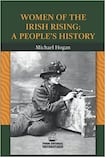
Michael Hogan is the internationally acclaimed Irish-American author of 27 books of history and historical fiction, novels, poetry, pedagogy and nonfiction, including the bestselling Irish Soldiers of Mexico – a history of the Irish battalion in Mexico, which was the inspiration for a stirring MGM film featuring Tom Berenger.
The germ of this book derives from conversations Hogan had with his grandfather, Cornelius McGillycuddy, who was 33 at the time of the Easter Rising and often spoke to the budding historian about the key roles women played in it.
Intrigued, for many years afterwards the author searched for documentary evidence of this. During the course of his research he came across numerous articles, journals, diaries and biographies written by or about some of the women who participated in the Rising, but found that the majority of the books written about women combatants were by academics and intended for a scholarly audience. He concluded that, whether by omission or design (See Chapter 22: “Airbrushed from History?”), the full story had yet to be told.
I spent my formative years in the Irish midlands and was educated in classrooms haunted by the shades of Connolly and Pearse. I remember going on school trips to Ros Muc, in the Connemara Gaeltacht, to visit Pearse’s summer cottage, and feeling a sense of reverence. On another occasion, my father drove us to Dublin to visit Kilmainham Gaol, where we met the last (male) survivor of the Rising. I cradled the pamphlet Paddy Butner signed for me all the way back to Longford like a sacred relic.
But despite having excellent teachers, looking back I find I cannot remember the name of a single female participant in the Irish Rising, save a vague notion of Countess Markiewicz serving as a muse for the poet William Butler Yeats, whose writings influenced Pearse and some of the other rebel leaders who were shot on Easter Sunday. Since then, a number of excellent books about the Rising have appeared, with many providing clear insights into the causes, accounts of the street battles, and the aftermath – yet women remained marginal figures reduced to the role of assistants to the male combatants – primarily cooks, nurses, and message-bearers.
Until now. In his author’s note, Hogan states his reason for writing this book was to provide “an accessible and compelling narrative which preserved the drama and contradictory elements of the struggle and integrated the activities of the women as part of a seamless whole.”
In this he succeeds admirably. Women of the Irish Rising is written in lucid, engaging prose that will appeal to both historian and layman. The action ranges across multiple countries, and while the book is carefully researched, historically accurate, and packed with primary and secondary sources, along with detailed maps, there is no sense of pedantic ennui. Hogan uses his evidence skillfully and imaginatively, and the narrative unfolds with the intensity and dramatic pace of a well-crafted novel.
The book lists the names and exploits of too many powerful and intrepid women to mention them all in this review, but without the work of Molly Childers and Mary Spring Rice (who smuggled arms in on Asgard, the Childers’ 28-ton yacht), 1,500 Howth (Mauser) rifles would not have been available to the Irish Volunteers. Those rifles and thousands of rounds of ammunition made a huge impact throughout the Rising, especially in the defence of Mount Street, where the thick smoke and lethal volleys of these rifles unnerved the newly arrived British Crown forces.
Constance Markievicz also made a huge personal contribution to the Rising, in her paramilitary training of young men, and her leadership at St. Stephen’s Green and later at the College of Surgeons. Additionally, she sold off some of her jewels to buy automatic pistols such as C96 Mausers, which also proved useful in the close quarters urban fighting.
In addition to these influential, largely upper-class women with wealth and weaponry at their disposal, we must also mention Margaret Skinnider, who set explosive charges and proved a crack sniper. But even more effective was the use of women, of all social backgrounds, to transport messages between the web of rebel posts – an activity men could not have engaged in as they would have been searched, captured or shot by British sentries.
A socialist and feminist, Connolly believed he was fighting a people’s war of emancipation, and therefore encouraged women to fight in the front lines alongside the men, whereas Pearse and Éamon de Valera were implacably opposed.
From a military viewpoint the Rising was a failure, but it proved to be a pyrrhic victory for the British authorities, as it sparked the partially successful Irish War of Independence. Over 250 women fought alongside their male counterparts, 70 were imprisoned, and one – Countess Markievicz – was sentenced to death.
Women of the Irish Rising is a timely and useful corrective to previous books on the subject, many of which downplayed the the crucial role women played in the planning, financing and execution of this seminal event in Irish history. After reading it, twice, I felt like someone who was watching a fascinating movie and suddenly had the sight fully restored to his weakest eye.
My only quibble is that the chapters seemed a tad too short, but that is how I always feel when I come to the end of a great read. I urge you to buy this book, and I also strongly recommend Hogan’s The Irish Soldiers of Mexico – a book for the ages.










